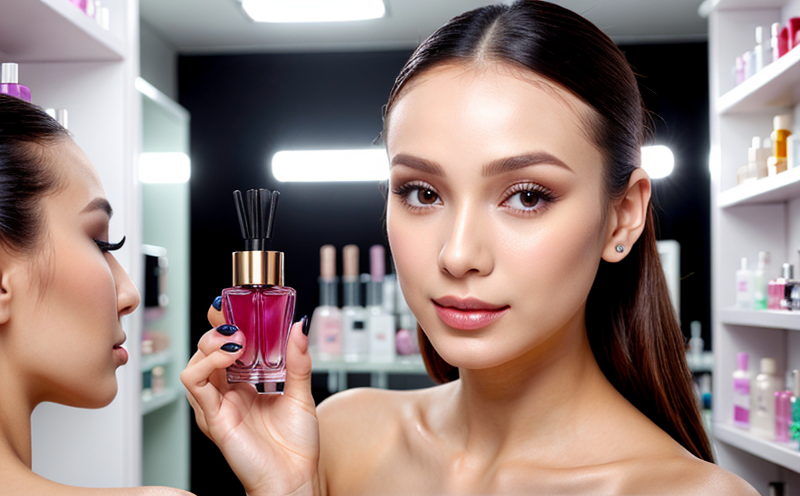Volatility Testing of Cosmetic Fragrances
The volatility testing of cosmetic fragrances is a critical component in ensuring the quality, performance, and consumer safety of cosmetic products. Understanding how fragrance components behave over time ensures that formulations meet regulatory requirements and deliver consistent sensory experiences to consumers.
Fragrance volatilization can significantly impact product stability, efficacy, and shelf life. This test evaluates the rate at which a fragrance evaporates from a cosmetic formulation under controlled conditions. The primary goal is to determine the optimal concentration of ingredients that will provide an acceptable aroma profile while minimizing evaporation rates.
Accurate volatility testing helps manufacturers optimize their formulas by identifying the most stable and effective combinations of aromatic compounds. This process involves rigorous laboratory methods, precise measurement techniques, and adherence to international standards such as ISO 29146:2017 for fragrance stability tests.
To perform this test effectively, samples must be prepared according to specific protocols. Specimens are typically sealed in vials or containers that simulate real-world storage conditions. Temperature and humidity levels mimic those found in various climates around the globe, allowing researchers to assess how different environments affect fragrance longevity.
Once prepared, these specimens undergo rigorous testing using advanced analytical instruments capable of measuring vapor pressure changes over extended periods. These devices provide detailed data on evaporation rates at both ambient temperatures and higher temperatures simulating accelerated aging processes.
The results generated from volatility tests play a vital role in formulating effective fragrances that not only smell pleasant but also last longer without compromising quality or safety. By understanding the exact behavior of each ingredient under various conditions, developers can make informed decisions about product design and packaging.
Applied Standards
The volatility testing procedure for cosmetic fragrances adheres to several internationally recognized standards designed to ensure accuracy and consistency across industries. One such standard is ISO 29146:2017, which provides guidelines on determining the stability of volatile organic compounds (VOCs) in personal care products.
ASTM E358-14 also offers relevant information regarding the measurement of VOC emissions from consumer goods. Additionally, European Union regulations mandate compliance with EN 14960 series standards when conducting similar tests within EU member states.
These guidelines emphasize the importance of controlled environments during sample preparation and analysis to minimize external variables that could influence results. They also stress the need for reproducible methods capable of producing reliable data across multiple laboratories.
Industry Applications
Fragrance volatilization testing plays a crucial role in several key areas:
- Evaluating the longevity and persistence of fragrances in finished products.
- Detecting potential issues early in development stages to prevent costly recalls later on.
- Optimizing ingredient selection based on empirical evidence rather than guesswork alone.
| Application Area | Description |
|---|---|
| Formulation Development | Determines the best balance between scent intensity and longevity. |
| Regulatory Compliance | Aids in meeting local and international regulations governing VOC emissions. |
| Packaging Design | Assists in selecting appropriate packaging materials that enhance fragrance stability. |
Why Choose This Test?
The volatility testing of cosmetic fragrances offers numerous benefits for businesses operating within the beauty and personal care sectors:
- Enhanced Consumer Satisfaction: Customers expect consistent aromatherapy experiences regardless of where or how they purchase a product.
- Better Quality Control: Identifying weak points early allows companies to address them before releasing products to market.
- Informed Decision Making: Data-driven insights contribute significantly towards improving overall R&D efforts and innovation cycles.
- Increased Efficiency: Streamlined processes lead to reduced development times and lower costs associated with rework or redesign.
By investing in comprehensive volatility testing, beauty brands can build trust among their target audiences while maintaining competitive advantages through superior offerings.





